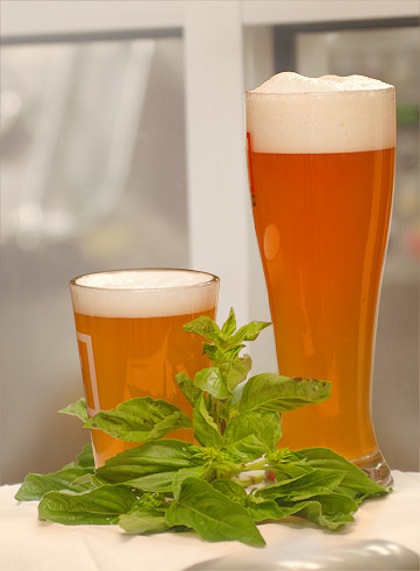For the first six millennia of mankind’s “relationship” with beer, brewers were more like chefs than they have been during the last 500 years.
In the Americas, native and colonial brewers gathered a laundry list of ingredients to make beer—everything from pumpkin to spruce.
Ancient brewers used available grains to create fermentable sugars and then balanced that flavor with a bevy of ingredients used as bittering agents. Flowers, herbs, berries, roots and even mushrooms were employed by early brewmasters. The first use of hops is credited to Bohemian brewers in the 8th or 9th century, but the practice was far from universal. A medieval drinker was more likely to sip beer flavored with heather, dandelion or even moss.

(Kinsley Dey)
It was left to the Germans to try to bring some order to this situation. In 1489, Bamberg’s Prince Bishop Heinrich III decreed that “nothing other than hops, malt and water” be used in brewing beer for the good people of Franconia. In 1516, the Reinheitsgebot spread these rules to the rest of Bavaria. Soon, most brewers abandoned the spice rack in favor of exclusively using hops.
There are traditional exceptions to the rule. Belgian brewers have long thumbed their noses at their rigid German neighbors. Some brews from Scandinavia, the British Isles and elsewhere around Europe continued to use various spices and bittering ingredients, along with hops. In the Americas, native and colonial brewers gathered a laundry list of ingredients to make beer—everything from pumpkin to spruce. The modern wave of domestic craft holiday and seasonal brews that utilize spices married to the time of year has opened the minds of many brewers to the benefits of garden-inspired brews.
Sam Calagione at Dogfish Head Craft Brewery in Delaware has been one of the innovators when it comes to using garden ingredients in beers. A partial list of the spices, fruits and vegetables used by Dogfish Head includes cumin, coriander, cloves, spearmint, peppermint, three kinds of peppercorns, juniper berries, St. John’s wort, thyme, lemongrass, vanilla beans, licorice root, nutmeg, cardamom, tamarillos, za’taar, chamomile, allspice, cinnamon, mace, grains of paradise, various teas, pineapple, mint, salt and lavender.
I have a few favorites. You get different flavors and aromas from different peppercorns, which is nice. We use juniper berries in two beers―Sah’tea and Immort―and I love the lemongrass in our Namaste,” says Calagione.
Not all experiments with garden ingredients work out. In 1996, Calagione made a beer with lavender buds, but “added too much and freaked people out.” Calagione’s first homebrew in 1993 used cherries and he says it turned out great. But his third homebrewed batch included peppercorns and he says he added “too much and it sucked.” This did not dissuade Calagione from using spices. His first commercial batch at Dogfish Head was Punkin Ale with allspice, nutmeg, cinnamon and brown sugar.
Calagione advises homebrewers working with garden ingredients to go low and slow in building a recipe. “Make a tea with it before brewing. This will better allow you to recognize the flavors and aromas it is bound to contribute and its intensity,” he says, noting that you want “the right presence in flavor and aroma, without being overpowering.”










